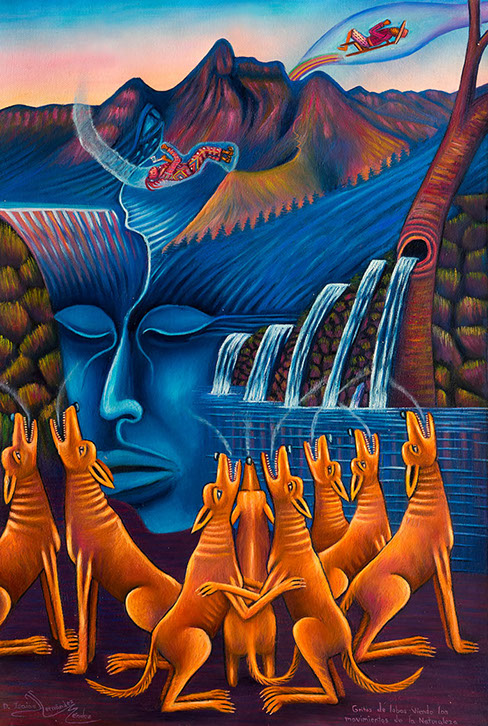



Symbolic Sibling Rivalry
in a Guatemalan Indian Village
By Benjamin D. Paul, Stanford University
Introduction
I. Socialization Patterns
II. Definition of Danger
III. Cultural Assumptions
IV. Fear of Being Eaten
V. Summary
Chapter Five
Summary
To avert the death of a newborn infant the people of San Pedro occasionally kill a chicken by beating it against the back of an older child who is then served the cooked fowl with the warning that he desist from "eating" his little brother or sister. Taken at its face value, that is, at the level of manifest function, the ritual is an instrumental act—a means of influencing events—whose logic is part and parcel of the "primitive world view" which Guatemalan Indians combine with "civilized social relations" in Tax's words.19 While it is a nonrational expedient from our point of view, it "makes sense" to the natives in terms of certain assumptions implicit in their culture. These assumptions have been stated above.

"Gritos de Lobos Viendo los Movimientos de la Naturaleza," cries of wolves seeing the movements of nature. Hernández depicts animals as seeing aspects of nature that normal humans do not see. They like shamans can see the spirit of such things as mountains or the wind. Painting by Diego Isaias Hernández Mendez, 2014.
Analysis of the ritual on the level of latent function, however, indicates that it serves a number of purposes apart from its avowed function of forestalling misfortune. For one thing it is an institutionalized means of relieving the intolerable pressure to "do something" and of finding an acceptable scapegoat in time of emotional crisis.
econdly it gives symbolic expression to repressed antisocial sentiments which have their source in the social experience of the individual beginning in early childhood and continuing into adult life. Sibling antagonism is imputed in the form of an oral-aggressive projection, which is also indicative of parent-child tensions. These tensions are disallowed byproducts of a social system which emphasizes emotional constraint and respect for authority. An assumed magical connection between fetus, sibling and parent provides a frame of reference for linking the fate of an infant with the appetite of its sibling. Belief that the death of a baby may be due to the appetite of another child is a specific instance of a more general disposition to entertain fantasies of being eaten.
Finally it should be understood that the sibling ritual not only reflects social strains. As part of the San Pedro culture pattern it also plays a role in defining the way in which sibling relations are perceived and experienced.
References
19 Tax, 1941.
Benjamin D. Paul
HARVARD UNIVERSITY
CAMBRIDGE, MASSACHUSETTS
1950
Bibliography
EGGAN, DOROTHY, 1949, The Significance of Dreams for Anthropological Research, American Anthropologist, n.s. Vol. 51, pp. 177-198.
GESELL, ARNOLD, et al., 1940, The First Five Years of Life, New York, Harper & Bros.
GILLIN, JOHN, 1947, Moche, A Peruvian Coastal Community, Smithsonian Institution, Institute of Social Anthropology, Pub. 3, U. S. Printing Office.
HENRY, JULES AND ZUNlA, 1944, Doll Play of Pilagá Indian Children, Research Monographs No. 4, American Orthopsychiatric Association, New York.
HENRY, WILLIAM. E., 1937, The Thematic Apperception Technique in the Study of Culture-Personality Relations, Genetic Psychology Monographs, Vol. 35, Provincetown.
KLUCKHOHN, CLYDE, 1944, Navaho Witchcraft, Papers of the Peabody Museum of American Archaeology and Ethnology, Harvard University, Vol. 22, No.3, Cambridge, Mass.
LEVY, DAVID M., 1939, Sibling Rivalry Studies in Children of Primitive Groups, American Journal of Orthopsychiatry, Vol. 9, pp. 205-214.
MEAD, MARGARET, 1947, Age Patterning in Personality Development, American Journal of Orthopsychiatry, Vol. 17, pp. 231-240.
REDFIELD, ROBERT AND MARGARET P., 1940, Disease and Its Treatment in Dzitas, Yucatan, Carnegie Institution of Washington, Publication 523, pp. 4~81.
TAX, SOL, 1937, The Municipios of the Midwestern Highlands of Guatemala, American Anthropologist, n.s. Vol. 39, pp. 423-447.
—,1941, World View and Social Relations in Guatemala, American Anthropologist, n.s. Vol. .43, pp. 27-42.
VILLA ROJAS, ALFONSO, 1947, Kinship and Nagualism in a Tzeltal Community, Southeastern Mexico, American Anthropologist, n.s. Vol. 49, pp. 578-587.